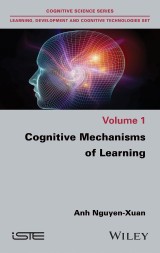Details

Cognitive Mechanisms of Learning
1. Aufl.
|
139,99 € |
|
| Verlag: | Wiley |
| Format: | EPUB |
| Veröffentl.: | 16.07.2020 |
| ISBN/EAN: | 9781119750475 |
| Sprache: | englisch |
| Anzahl Seiten: | 320 |
DRM-geschütztes eBook, Sie benötigen z.B. Adobe Digital Editions und eine Adobe ID zum Lesen.
Beschreibungen
Cognitive Mechanisms of Learning presents experimental research works on the issue of knowledge acquisition in Cognitive Psychology. These research works – initiated by groups of researchers with academic backgrounds in Philosophy, Psychology, Linguistics and Artificial Intelligence – explore learning mechanisms by viewing humans as information processing systems. Although the book is centered on research studies conducted in a laboratory, one chapter is dedicated to applied research studies, derived directly from the fundamental research works. Computer modeling of learning mechanisms is presented, based on the concept of �cognitive architecture�. Three important issues – �the methodology�, �the achievements� and �the evolution� – in the field of learning research are also examined.
<p>Foreword ix</p> <p>Acknowledgments xiii</p> <p>Introduction xv</p> <p><b>Chapter 1. Useful Concepts and Representation Formalisms </b><b>1</b></p> <p>1.1. Useful concepts 1</p> <p>1.1.1. Information 1</p> <p>1.1.2. Information processing 2</p> <p>1.1.3. Problem 2</p> <p>1.1.4. Comprehension 4</p> <p>1.1.5. Memory 6</p> <p>1.2. Some formalisms used in cognitive psychology to represent knowledge stored in the LTM 10</p> <p>1.2.1. Semantic networks: a representation formalism for declarative knowledge 11</p> <p>1.2.2. A representation formalism for procedural knowledge 13</p> <p>1.2.3. A representation formalism for the comprehension process 16</p> <p><b>Chapter 2. Definition and Historical Overview </b><b>23</b></p> <p>2.1. Definition 23</p> <p>2.2. Conceptual frameworks 26</p> <p>2.3. Principal concepts of problem-solving 28</p> <p>2.3.1. The “problem space” and “path” concepts 29</p> <p>2.3.2. The “heuristic” and “search tree” concepts 32</p> <p>2.4. Formal models 35</p> <p>2.4.1. Models based on rules of production 36</p> <p><b>Chapter 3. Learning to Solve a Problem </b><b>43</b></p> <p>3.1. Breaking down a complex problem into sub-problems 44</p> <p>3.1.1. Lee, J. and Anderson, J.R. (2001) 44</p> <p>3.2. The four stages of problem-solving 52</p> <p>3.2.1. Anderson, Pyke and Fincham (2016) 52</p> <p>3.3. The three stages of learning by problem-solving 56</p> <p>3.3.1. Tenison, Fincham and Anderson (2016) 56</p> <p><b>Chapter 4. Learning a Concept from Examples of Concepts: Induction </b><b>63</b></p> <p>4.1. Rule-based category learning 67</p> <p>4.2. The question of “confirmation bias” 72</p> <p>4.3. The duality between rule-based concept identification and similarity-based concept identification 75</p> <p>4.4. Concluding remarks 85</p> <p><b>Chapter 5. Implicit Learning </b><b>89</b></p> <p>5.1. Presentation 89</p> <p>5.2. What have learners learned, and are they aware of the knowledge which they acquire? 92</p> <p>5.2.1. The princeps research work 92</p> <p>5.2.2. What knowledge does the subject need to acquire? 99</p> <p>5.3. Fragment status and the question of “abstract” or “concrete” acquired knowledge 102</p> <p>5.3.1. The status of fragments in artificial grammar learning experiments 102</p> <p>5.3.2. The nature of acquired knowledge: abstract or concrete? 104</p> <p>5.4. Conclusion on implicit learning 107</p> <p>5.4.1. Implicit learning and statistical learning 107</p> <p>5.4.2. Individual differences 109</p> <p>5.4.3. Statistical learning mechanisms 110</p> <p>5.4.4. Applications of statistical learning 111</p> <p><b>Chapter 6. The Role of Prior Knowledge in Constructing a Representation of a Problem </b><b>113</b></p> <p>6.1. Experimental method based on comparing group results 114</p> <p>6.2. Experimental method based on multiple trials of the same problem with vocal description of actions by the subject: individual protocol and modeling 123</p> <p>6.3. Experimental method using learning transfer to study the effect of problem presentation in the choice of prior knowledge 126</p> <p>6.3.1. General hypotheses 127</p> <p>6.3.2. Material used 128</p> <p>6.3.3. Experimental hypotheses 131</p> <p>6.3.4. The experiments 132</p> <p>6.3.5. Conclusion 139</p> <p>6.4. Conclusion: the role of prior knowledge in the construction of problem representations 139</p> <p><b>Chapter 7. Acquiring Knowledge in a Specific Domain </b><b>143</b></p> <p>7.1. Learning through (self-)explanation 143</p> <p>7.1.1. Learning to solve problems by studying examples of solutions 144</p> <p>7.1.2. Acquisition of declarative knowledge concerning the human circulatory system 147</p> <p>7.1.3. Knowledge acquisition in physics 154</p> <p>7.1.4. Brief conclusion 160</p> <p>7.2. Problem-based learning 161</p> <p>7.2.1. Results 164</p> <p>7.3. Appendix: some notes on cognitive load theory 165</p> <p><b>Chapter 8. Causal Learning </b><b>169</b></p> <p>8.1. Historical overview 170</p> <p>8.2. Conceptual framework 172</p> <p>8.2.1. Temporal and spatial contiguity 172</p> <p>8.2.2. Temporal priority: cause before effect 173</p> <p>8.2.3. Contingency 174</p> <p>8.2.4. Prior experience 175</p> <p>8.3. Formalization and experimental research on adults 176</p> <p>8.3.1. Probabilistic models of causal learning 177</p> <p>8.3.2. Two examples of research on adults 180</p> <p>8.3.3. Causal learning in adults: conclusion 193</p> <p>8.4. Experimental research on children 194</p> <p>8.4.1. The above/below relation 196</p> <p>8.4.2. The “same/different” relation 198</p> <p>8.4.3. Knowledge of the domain in which a problem situation is represented 200</p> <p>8.4.4. Self-directed learning in children 203</p> <p>8.4.5. Conclusion: causal learning in children 204</p> <p><b>Chapter 9. Symbolic Processing System Models in Cognitive Psychology </b><b>213</b></p> <p>9.1. Why formalize? 213</p> <p>9.2. Modeling complex skill acquisition using ACT-R 214</p> <p>9.3. Modeling a two-player game 219</p> <p>9.4. A model of learning through multiple analogies 229</p> <p>9.4.1. Knowledge acquisition: first type 230</p> <p>9.4.2. Knowledge acquisition: second type 232</p> <p>9.5. Robert Siegler’s two models for learning arithmetic calculation 239</p> <p>9.6. Links between SPS models in cognitive psychology and learning models in AI 247</p> <p>Conclusion 251</p> <p>References 261</p> <p>Index 285</p>
Anh Nguyen-Xuan is a retired director of research at the French National Center for Scientific Research (CNRS). Her research works are mainly interdisciplinary (Cognitive Psychology, Artificial Intelligence, Didactics of Physics, Didactics of Mathematics) and focused on learning and cognitive development.
Diese Produkte könnten Sie auch interessieren:

Cognitive-Behavioural Therapy for ADHD in Adolescents and Adults

von: Susan Young, Jessica Bramham

41,99 €

Cognitive-Behavioural Therapy for ADHD in Adolescents and Adults

von: Susan Young, Jessica Bramham

41,99 €

Offenders with Developmental Disabilities

von: William R. Lindsay, John L. Taylor, Peter Sturmey

53,99 €













